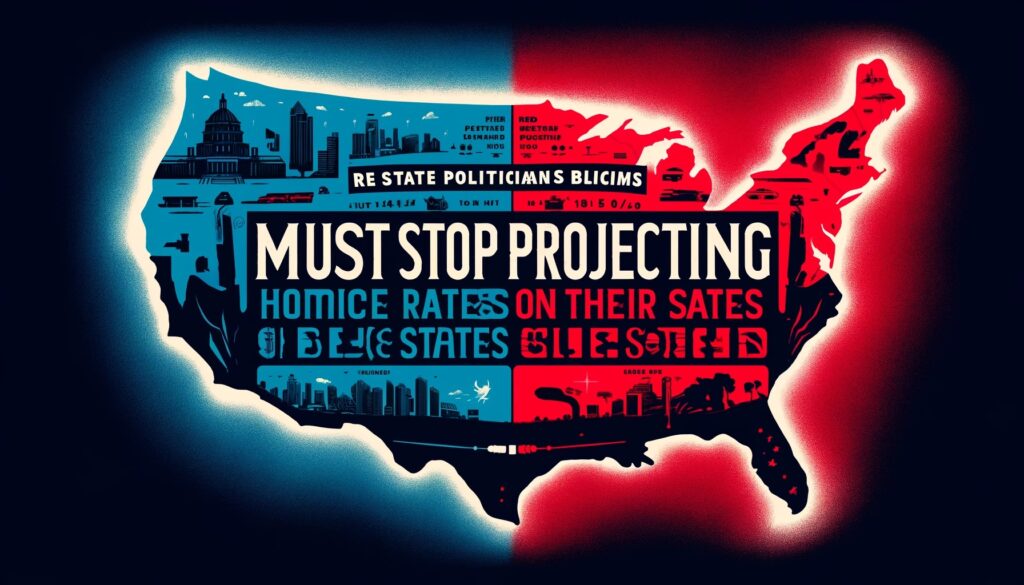Red State politicians constantly knock the Blue States for their crime, taxes, and more. Unfortunately for them, it is their states with exploding homicide rates.
Red State politicians project!
Podcasts (Video — Audio)
The persistent narrative that blue states are bastions of crime while red states are safe havens of law and order has been a cornerstone of conservative rhetoric for years. Politicians from red states often point fingers at cities like Baltimore and Chicago, selectively highlighting instances of violence to paint a broad picture of urban decay under Democratic leadership. However, a closer examination of the data reveals a starkly different reality: red states experience significantly higher homicide rates than their blue counterparts. This discrepancy underscores the urgent need for conservative politicians to stop projecting and start addressing the pressing issues within their own jurisdictions.
Historically, red states have depended more on federal support to balance their budgets and provide essential services to their citizens. This reliance on federal aid is not a matter of opinion but a well-documented fact. States like Mississippi, Alabama, and Louisiana receive a disproportionate amount of federal funds compared to what they contribute in taxes. In contrast, blue states such as California and New York are net contributors, often subsidizing the financial shortfalls of their red-state counterparts. This dynamic is crucial to understanding the socio-economic landscape contributing to varying state crime rates.
The myth that economic prosperity drives people to red states does not hold up under scrutiny. While lower living costs and taxes can attract individuals, these factors do not paint the full picture. Economic migration often masks deeper systemic issues, such as underfunded public services and inadequate social safety nets, which are prevalent in many red states. These systemic issues create environments where crime can thrive, particularly in areas where poverty and lack of opportunity are rampant.
Homicide rates provide a clear indicator of the underlying social and economic health of a state. From 2012 to 2022, homicide rates increased across the United States, but the increase was not evenly distributed. Red states experienced some of the most significant spikes in homicide rates during this period. For instance, Mississippi saw a staggering 103% increase, while Louisiana experienced a 64% rise. Other red states like Alabama, Missouri, and Georgia reported increases of 71%, 75%, and 74%, respectively. These figures starkly contrast with some blue states, where the increases were more modest or even decreased in some cases. Connecticut and New Jersey, for example, saw decreases of 2.3% and 20.8%, respectively.
The socio-economic context within these states plays a critical role in these crime statistics. Red states, which often invest less in public education, healthcare, and social services, create environments where crime can flourish. The lack of investment in these crucial areas leaves many residents without the necessary support systems, driving some to resort to crime out of desperation. The parallels between impoverished urban areas and rural communities in red states highlight this issue. Whether in the inner-city neighborhoods or the rural expanses of Appalachia, the challenges of poverty and lack of opportunity manifest similarly.
The projection by red state politicians, blaming blue states for high crime rates while ignoring their own escalating homicide rates, is a diversionary tactic that fails to address the root causes of violence. This misdirection prevents meaningful discussions and solutions that could improve their constituents’ safety and quality of life. Instead of perpetuating a false narrative, these politicians should address the systemic issues within their states, such as inadequate education systems, underfunded healthcare, and insufficient economic opportunities.
The reliance of red states on federal funds, juxtaposed with their higher crime rates, further complicates the conservative narrative of self-reliance and fiscal responsibility. The data suggests that red states are, in fact, more dependent on the federal government and face greater socio-economic challenges than their blue state counterparts. This reality calls for reevaluating policies and priorities at the state level, emphasizing investment in public services and community development to address the root causes of crime.
Moreover, the conservative emphasis on low taxes and minimal government intervention often leads to underfunded public services that exacerbate the very problems they seek to solve. Effective crime reduction strategies require robust investment in education, healthcare, and social services, which can create safer and more prosperous communities. By addressing these foundational issues, red states can reduce crime rates and improve the overall well-being of their residents.
The data on homicide rates and federal dependency paints a clear picture: red states face significant challenges that cannot be ignored. It is time for red-state politicians to stop projecting their issues onto blue states and take responsibility for addressing the systemic problems within their own jurisdictions. By investing in public services and creating opportunities for their residents, red states can break the cycle of poverty and crime, ultimately creating safer and more prosperous communities for all. This shift in focus will not only benefit the residents of red states but also contribute to a more balanced and equitable
Viewers are encouraged to subscribe and join the conversation for more insightful commentary and to support progressive messages. Together, we can populate the internet with progressive messages that represent the true aspirations of most Americans.

